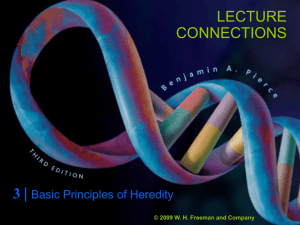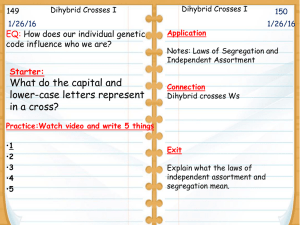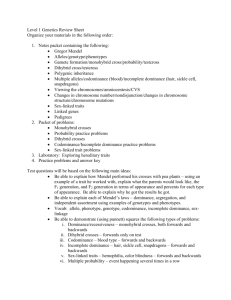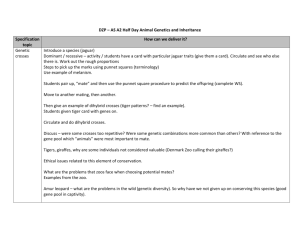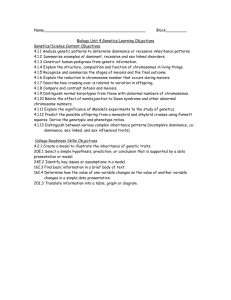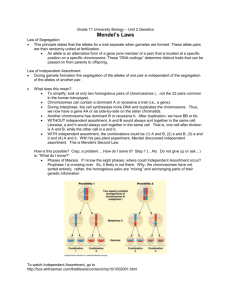Pierce Genetics: A Conceptual Approach 3e
advertisement
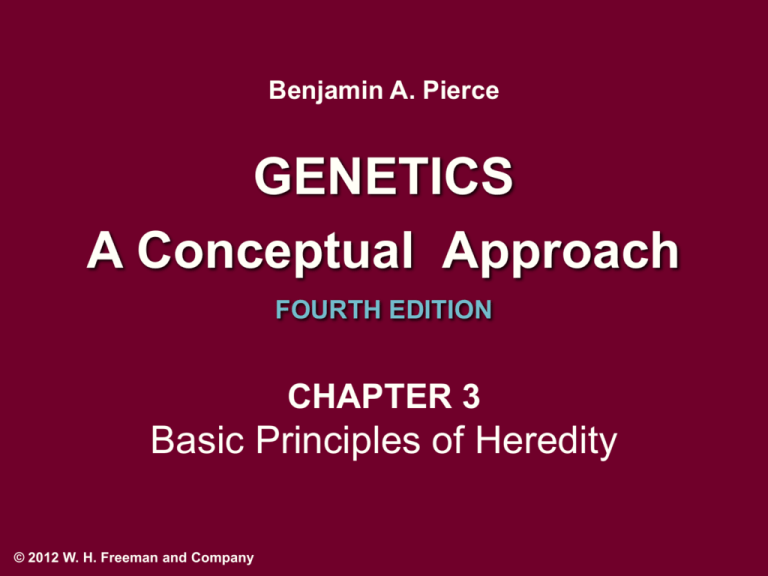
Benjamin A. Pierce GENETICS A Conceptual Approach FOURTH EDITION CHAPTER 3 Basic Principles of Heredity © 2012 W. H. Freeman and Company Chapter 3 Outline • 3.1 Gregor Mendel Discovered the Basic Principles of Heredity, 44 • 3.2 Monohybrid Crosses Reveal the Principle of Segregation and the Concept of Dominance, 47 • 3.3 Dihybrid Crosses Reveal the Principle of Independent Assortment, 56 • 3.4 Observed Ratios of Progeny May Deviate from Expected Ratios by Chance, 61 3.1 Gregor Mendel Discovered the Basic Principles of Heredity • Gregor Mendel and his success in genetics • Genetic terminology Table 3.1 & Figure 3.2 3.2 Monohybrid Crosses Reveal the Principle of Segregation and the Concept of Dominance • Monohybrid cross : cross between two parents that differ in a single characteristic. – Conclusion 1: one character is encoded by two genetic factors. – Conclusion 2: two genetic factors (alleles) separate when gametes are formed. – Conclusion 3: The concept of dominant and recessive traits. – Conclusion 4: Two alleles separate with equal probability into the gametes. Fig. 3.4 3.2 Monohybrid Crosses Reveal the Principle of Segregation and the Concept of Dominance • Principle of segregation: (Mendel’s first law) Each individual diploid organism possesses two alleles for any particular characteristic. These two alleles segregate when gametes are formed, and one allele goes into each gamete. • The concept of dominance: when two different alleles are present in a genotype, only the trait encoded by one of them – the “dominant” allele-is observed in the phenotype. 3.2 Monohybrid Crosses Reveal the Principle of Segregation and the Concept of Dominance • Relating Genetic Crosses to Meiosis – Chromosome theory of heredity Fig. 3.6 • Predicting the outcomes of genetics crosses – The Punnett square Fig. 3.7b Probability as a tool in genetics The multiplication rule The addition rule The application of probability to genetics crosses The binomial expansion and probability Concept Check 1 If an F1 plant depicted in Figure 3.4 is backcrossed to the parent with round seeds, what proportion of the progeny will have winkled seeds? ( Use a Punnett square.) a. ¾ b. ½ c. ¼ d. 0 Concept Check 1 If an F1 plant depicted in Figure 3.4 is backcrossed to the parent with round seeds, what proportion of the progeny will have winkled seeds? ( Use a Punnett square.) a. ¾ b. ½ c. ¼ d. 0 Concept Check 2 If the probability of being blood-type A is 1/8 and the probability of blood-type O is ½, what is the probability of being either blood-type A or O? a. 5/8 b. ½ c. 1/8 d. 1/16 Concept Check 2 If the probability of being blood-type A is 1/8 and the probability of blood-type O is ½, what is the probability of being either blood-type A or O? a. 5/8 b. ½ c. 1/8 d. 1/16 3.2 Monohybrid Crosses Reveal the Principle of Segregation and the Concept of Dominance • The Testcross - Fig. 3.7 • Ratios in Simple Crosses – Table 3.3 & 3.4 3.3 Dihybrid Crosses Reveal the Principle of the Independent Assortment Dihybrid Crosses – The principle of independent assortment • Fig. 3.10 – Relating the principle of independent assortment to meiosis – Applying probability and the branch diagram to dihybrid crosses • Fig. 3.11 – The Dihybrid testcross • Fig. 3.12 Concept Check 3 • How are the principles of segregation and independent assortment related and how are they different? Concept Check 3 • How are the principles of segregation and independent assortment related and how are they different? Answer: – Genes encoding different characteristics separate and assorted independently of one another when they do not locate close together on the same chromosome. – During this process, two alleles of the same gene encoding one characteristic still have to be segregated from each other during the formation of gametes.
